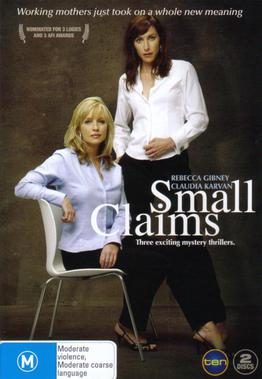Related Research Articles

Sea urchins or urchins are typically spiny, globular animals, echinoderms in the class Echinoidea. About 950 species live on the seabed, inhabiting all oceans and depth zones from the intertidal to 5,000 metres. Their tests are round and spiny, typically from 3 to 10 cm across. Sea urchins move slowly, crawling with their tube feet, and sometimes pushing themselves with their spines. They feed primarily on algae but also eat slow-moving or sessile animals. Their predators include sea otters, starfish, wolf eels, and triggerfish.
Halifax f.p. is an Australian television crime series produced by Nine Network from 1994 to 2002. The series stars Rebecca Gibney as Doctor Jane Halifax, a forensic psychiatrist (f.p.) investigating cases involving the mental state of suspects or victims. The series is set in Melbourne.

Rebecca Catherine Gibney is a New Zealand actress known for her roles on Australian television in The Flying Doctors, Halifax f.p., Packed to the Rafters, Winter and Wanted. She has also featured in a number of Australian films, including Mental and The Dressmaker. She is a Gold Logie winner
John Bach is a British-born New Zealand actor who has acted on stage, television and film over a period of more than four decades. Though born in the United Kingdom, he has spent most of his career living and working in New Zealand.

Nightmares & Dreamscapes: From the Stories of Stephen King is an eight-episode anthology miniseries that aired on TNT, based on short stories written by American author Stephen King. It debuted on July 12, 2006, and ended its run on August 2, 2006. Although most of the stories are from the book collection of the same title, some are from different collections by King. A trailer confirming a DVD edition of the series was released in October 2006. The series was filmed entirely in Melbourne, Australia.
The Scarecrow is a 1982 New Zealand film, also known as Klynham Summer in America. It was directed by Sam Pillsbury based on the 1963 horror novel by New Zealand author Ronald Hugh Morrieson.
Erebus: The Aftermath was a 1987 New Zealand television miniseries about Air New Zealand Flight 901, which crashed in Antarctica in 1979. The miniseries, a docudrama, was produced by Television New Zealand, and was broadcast in New Zealand and Australia. It was also aired by BBC 2 television in the UK. It was repeated by TVNZ to coincide with the 30th anniversary of the crash.

Small Claims is an Australian television film starring Rebecca Gibney and Claudia Karvan, which first aired on Network Ten in 2004. The film was a co-production with subscription television and was also broadcast on the Foxtel, Austar, and Optus Television Subscription Television services. The series was written by husband and wife team, Keith Thompson and Kaye Bendle.
Daybreak Pacific Ltd is a New Zealand film and television company. It produces low-budget films and programmes for the local and international market, often in association with other production or financing companies. It also known as Daybreak Pictures.
Kangaroo Palace is an Australian television drama miniseries which aired in 1997 on the Seven Network.

Beyond Reasonable Doubt is a 1980 New Zealand docu-drama feature film directed by John Laing and starring David Hemmings, John Hargreaves, Roy Billing, and Terence Cooper.

Gibney Beach, or Oppenheimer Beach, is a beach on Hawksnest Bay on northern Saint John in the United States Virgin Islands. The beach's names originate from Nancy Flagg Gibney and J. Robert Oppenheimer and their families, the owners of the beach in the mid-20th century. The beach has been mostly accessible to the public since its acquisition, and a community center has been created on the property, where Oppenheimer’s house used to be.

Roy Harwood Billing is a New Zealand television actor, now based on Waiheke Island, New Zealand. He was brought up in Ruawai, Northland, New Zealand. Billing spent almost three decades living and working in Australia. He became widely known for his role as organised-crime boss “Aussie Bob” Trimbole in the TV series Underbelly.
Zoo Family is an Australian children's television series broadcast on the Nine Network on 23 June 1985. The series was produced by Crawford Productions. It was filmed at the Melbourne Zoo. It was later shown in reruns on Nickelodeon in the United States.
Gibney may refer to:
The Academy of Canadian Cinema & Television's 13th Gemini Awards were held on October 4, 1998, to honour achievements in Canadian television.. The awards show, which was hosted by Ronnie Edwards and Kenny Robinson, took place at the Metro Toronto Convention Centre and was broadcast on CBC Television.

The Killing Field is an Australian mystery-drama-thriller television film on the Seven Network. It was created by Sarah Smith and Michaeley O'Brien and directed by Samantha Lang, from a screenplay by Sarah Smith and Michaeley O'Brien. It was produced by Bill Hughes and Sarah Smith with Rebecca Gibney co-producing and Julie McGauran executive producing. A spin-off series Winter screened from February 2015.
Small Claims: White Wedding is an Australian television film starring Rebecca Gibney and Claudia Karvan, which first aired on Network Ten in 2005. The film was a co-production with subscription television and was also broadcast on the Foxtel, Austar, and Optus Television Subscription Television services. The series was written by husband and wife team, Keith Thompson and Kaye Bendle.
Snowy is an Australian television drama thriller series that screened on the Nine Network in 1993 and was produced by Simpson Le Mesurier Films. The program was not renewed for a second season.

Bruce Robert Allpress was a New Zealand actor.